The Battle of the Neva was fought between the Novgorod Republic, along with Karelians, and the Kingdom of Sweden, including Norwegian, Finnish and Tavastian forces, on the Neva River, near the settlement of Ust-Izhora, on 15 July 1240. The battle is mentioned only in Russian sources, and it remains unclear whether it was a major invasion or a small-scale raid. In Russian historiography, it has become an event of massive scale and importance.
Alexander Nevsky Fighting the Swedes, by Boris Chorikov
Battle of the Neva contributed to Alexander's sainthood
The Novgorod Republic was a medieval state that existed from the 12th to 15th centuries in northern Russia, stretching from the Gulf of Finland in the west to the northern Ural Mountains in the east. Its capital was the city of Novgorod. The republic prospered as the easternmost trading post of the Hanseatic League, and its people were much influenced by the culture of the Byzantines, with the Novgorod school of icon painting producing many fine works.
Medieval walls of the Novgorod Detinets from the late 15th century. The Kokui tower (left) dates from the 17th century; its name is of Swedish origin.
Martha the Mayoress at the Destruction of the Novgorod Veche, painting by Klavdiy Lebedev (1889)
The removal of the veche bell from Novgorod, miniature from the Illustrated Chronicle of Ivan the Terrible (16th century)
A fragment of the icon Praying Novgorodians depicting the Kuzmin boyars (1467)






